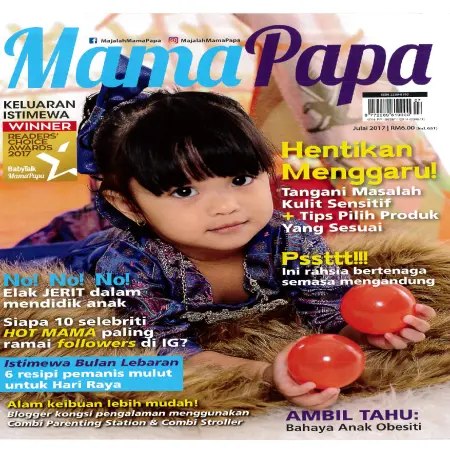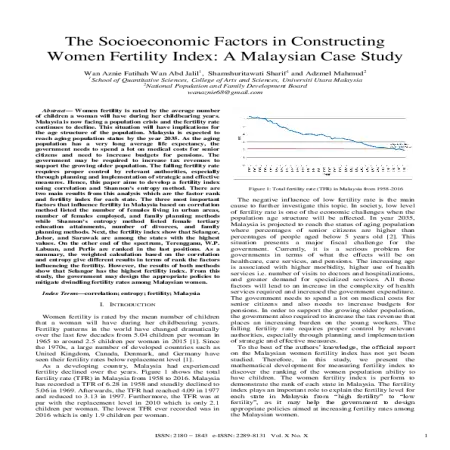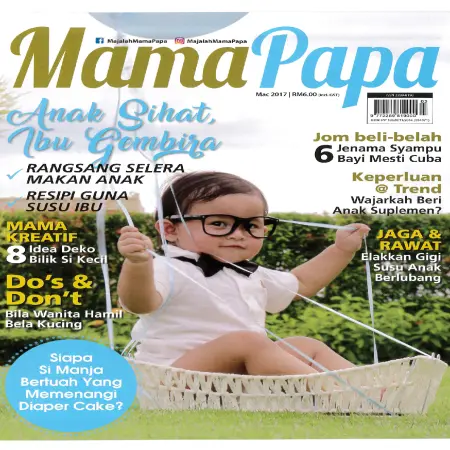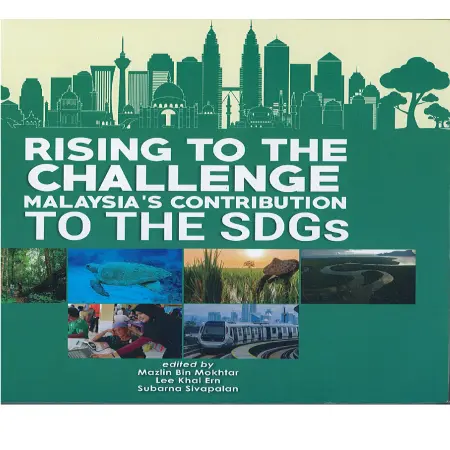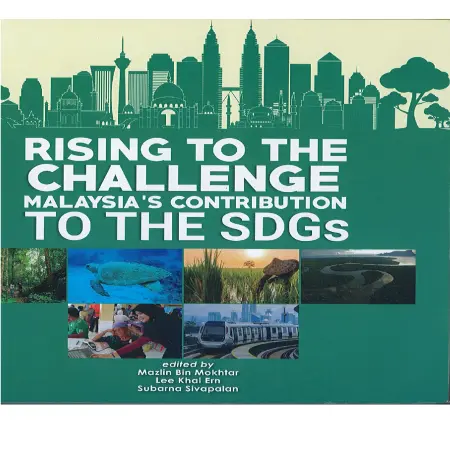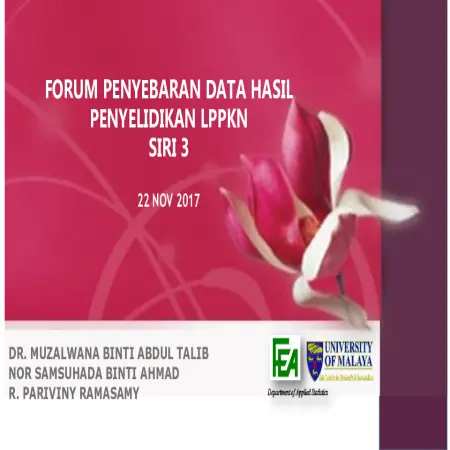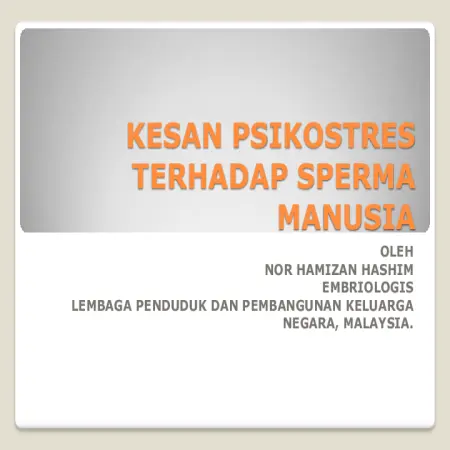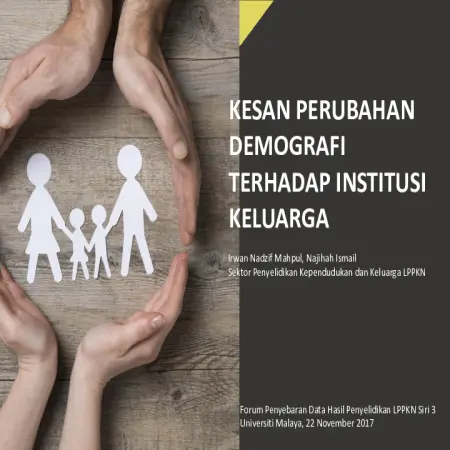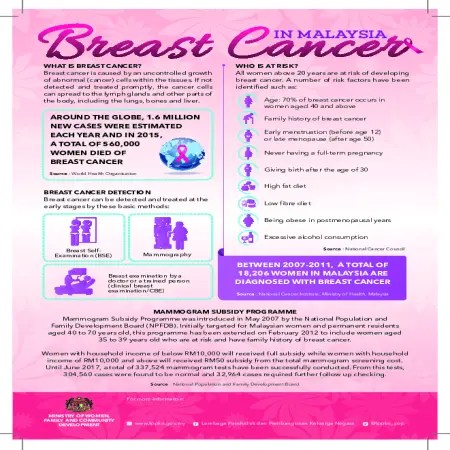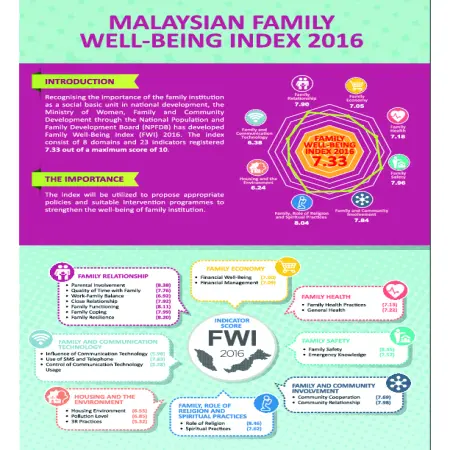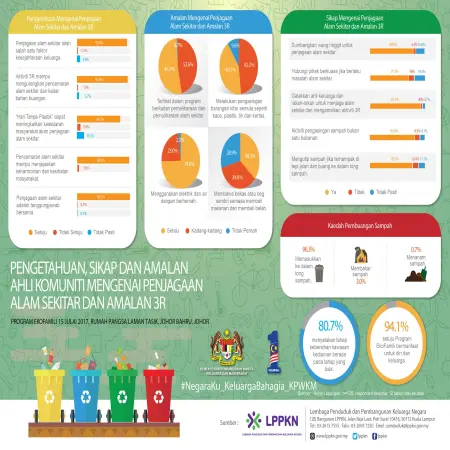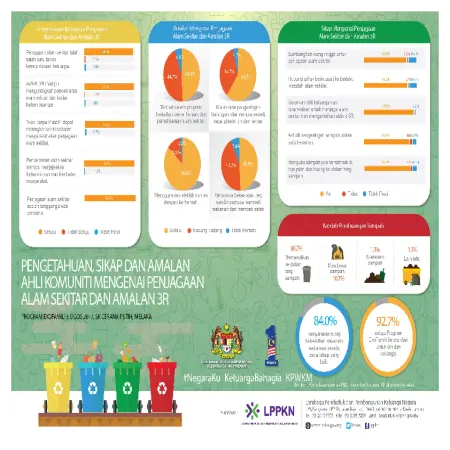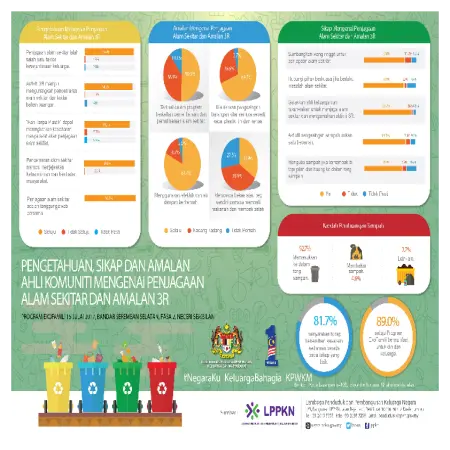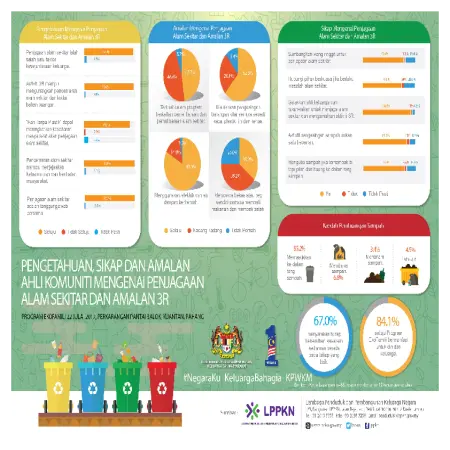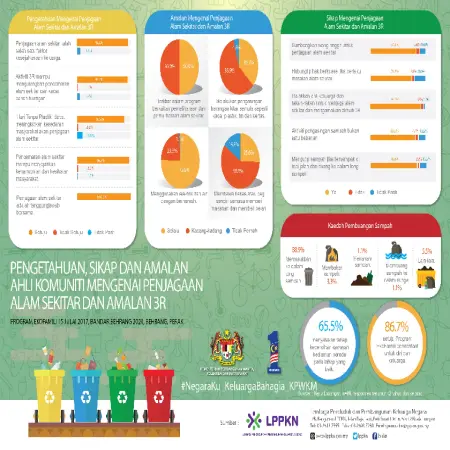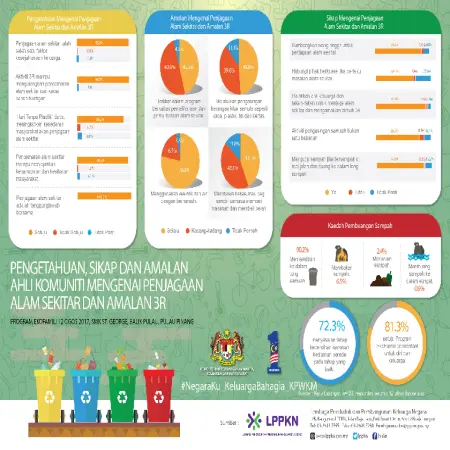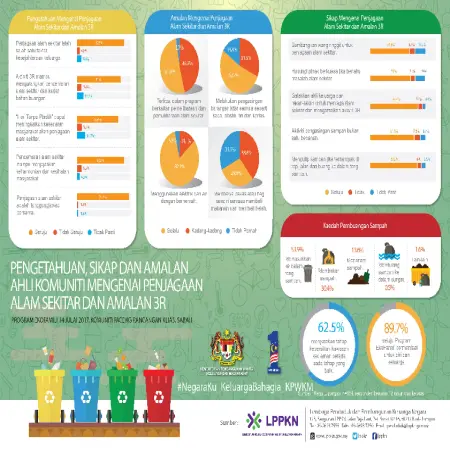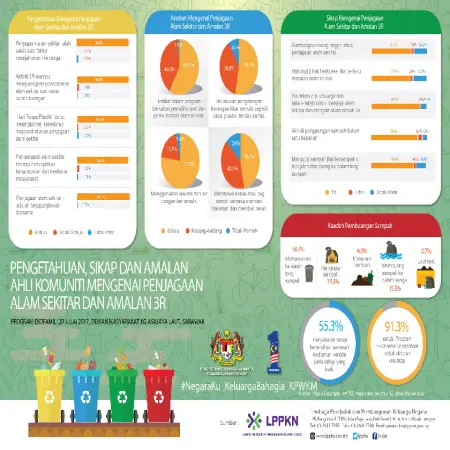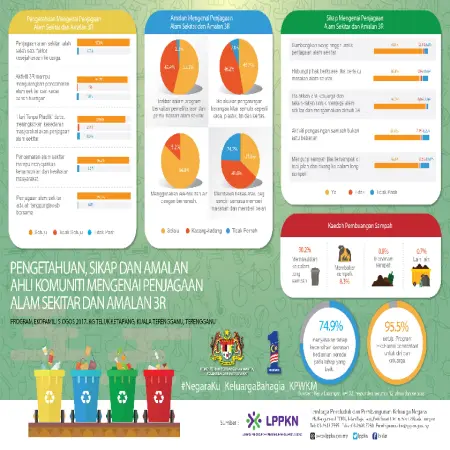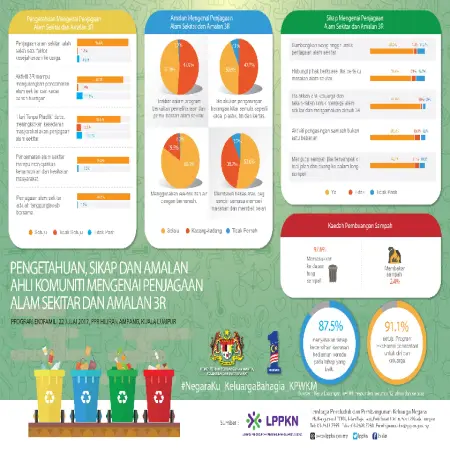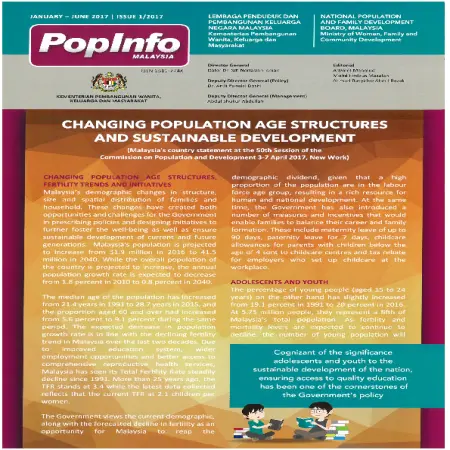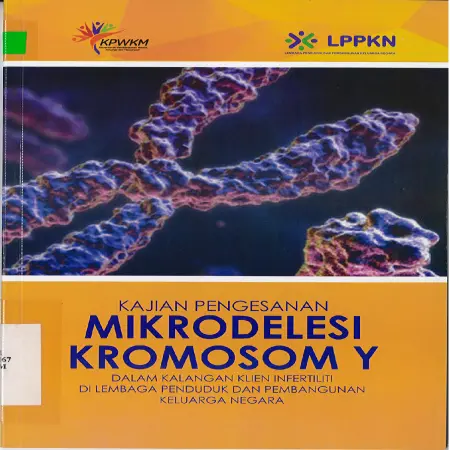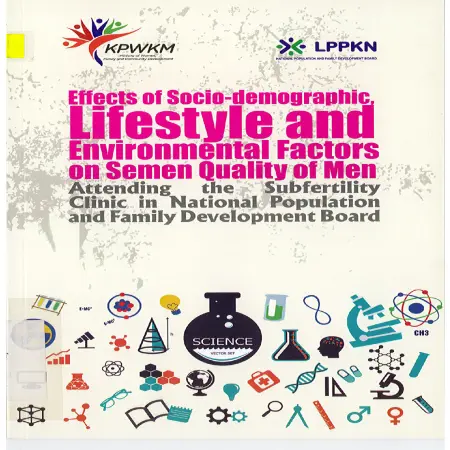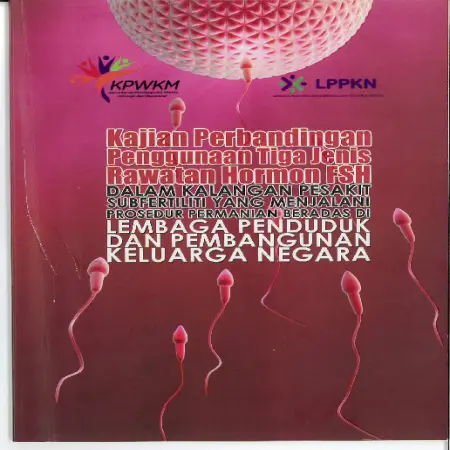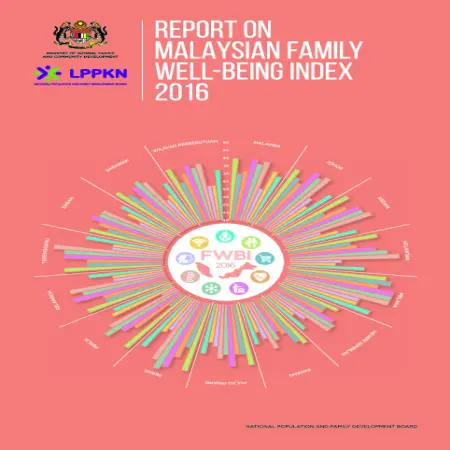Browse by Year
Results for Year : "2017"
Annual Report (1)
Article (4)
|
|
Ajar anak hargai ibu bapa
Item Type: Article
Editor:
Year: 00/07/2017
Abstract: Parents are the most important people in everyone's life. Their service to us is priceless. Ever since we were in the womb, the mother has carried us in her womb for 9 months and 10 days and it is the mother who gave birth to us. Not to be forgotten is also the role of the father who is the leader and takes care of us to the best of our ability. We can show love to our parents by respecting and obeying them. Our parents have instilled pure values in us and educated us since childhood to the best of our ability.
|
|
|
|
|
|
The socioeconomic factors in constructing women fertility index: a Malaysian case study
Item Type: Article
Editor:
Year: 01/06/2017
Abstract: Women fertility is rated by the average number of children a woman will have during her childbearing years. Malaysia is now facing a population crisis and the fertility rate continues to decline. This situation will have implications for the age structure of the population. Malaysia is expected to reach aging population status by the year 2035. As the aging population has a very long average life expectancy, the government needs to spend a lot on medical costs for senior citizens and need to increase budgets for pensions. The government may be required to increase tax revenues to support the growing older population. The falling fertility rate requires proper control by relevant authorities, especially through planning and implementation of strategic and effective measures. Hence, this paper aims to develop a fertility index using correlation and Shannon's entropy method. There are two main results from this analysis which are the factor rank and fertility index for each state. The three most important factors that influence fertility in Malaysia based on correlation method listed the number of females living in urban areas, number of females employed, and family planning methods while Shannon's entropy method listed female tertiary education attainments, number of divorces, and family planning methods. Next, the fertility index show that Selangor, Johor, and Sarawak are among the states with the highest values. On the other end of the spectrum, Terengganu, W.P. Labuan, and Perlis are ranked in the last positions. As a summary, the weighted calculation based on the correlation and entropy give different results in terms of rank the factors influencing the fertility. However, the results of both methods show that Selangor has the highest fertility index. From this study, the government may design the appropriate policies to mitigate dwindling fertility rates among Malaysian women.
|
|
|
|
|
|
Pedofilia: selamatkah anak-anak kita?
Item Type: Article
Editor:
Year: 00/05/2017
Abstract: Recently, we were shocked by a news that was very foreign to us. A British man has been convicted of molesting and sexually abusing children, including in Malaysia. The psychological disorder is called pedophilia, while the perpetrators of child sexual harassment are called pedophiles. A person who suffers from pedophilia, may also not be a pedophiles (for not committing any sexual behavior against children), but a pedophile turns out to be a person suffering from pedophilia.
|
|
|
|
|
|
Stress buat lelaki jadi kurang subur?
Item Type: Article
Editor:
Year: 00/03/2017
Abstract: Fertility problems are now increasing from time to time around the world. According to the World Health Organization (WHO 2010), infertility can be rooted; 40% of male factors or and 40% of female factors and 20% are from unknown factors (idiopathy).
|
|
|
|
Book Section (3)
|
|
Reproductive and social health education
Item Type: Book Section
Editor:
Year: 01/01/2017
Abstract: On 6th December 2009, the Cabinet approved the PEKERTI Policy & Action Plan proposed by Ministry of Women, Family and Community Development (MWFCD), which aims to guide young people from getting involved in social problems.
|
|
|
|
|
|
Mama Care
Item Type: Book Section
Editor:
Year: 01/01/2017
Abstract: One aspect of women's reproductive health care which is increasingly in demand is postnatal care services. In order to improve the welfare of women in low-income households and to recognise the skills traditionally passed down from generation to generation, Mama Care Postnatal Care Programme was established in 2012 under the 7th National Blue Ocean Strategy (NBOS), 1Malaysia Women's Initiative and Self Empowerment (1MWISE). It is targeted single mothers, elderly and women from low-income household.
|
|
|
|
|
|
Malaysian Family Wellbeing Index
Item Type: Book Section
Editor:
Year: 00/00/2017
Abstract: Family institutions need to be strengthened to balance the rapid process of social and economic development of the country. This is important because the family is the basic social unit that prepares the supplies the human capital for the national development. Given the importance of family wellbeing for the future of the nation, scientific studies ought to be conducted to measure the wellbeing of families in this country.
|
|
|
|
Conference or Workshop Item (5)
|
|
Perbandingan kesejahteraan psikologi wanita di kalangan keluarga komuter dan keluarga tradisional di Malaysia: satu kajian awal
Item Type: Conference or Workshop Item
Editor:
Year: 00/00/2017
Abstract: The objective of this study was to make a comparison of the psychological well -being of women among commuter families and not from commuter families based on the factors that contribute to the psychological well -being of each category. The study was also to compare female fertility levels among commuter families and non -commuter families.
|
|
|
|
|
|
Ke arah memantapkan sistem sokongan keluarga di Malaysia: pendekatan holistik dalam penyelesaian pertikaian keluarga
Item Type: Conference or Workshop Item
Editor:
Year: 00/00/2017
Abstract: This topic gives an overview of the institutions that are dealing with family disputes in Malaysia. Generally, these institutions can be divided into judicial institutions and non-judicial institutions. Judicial institutions refer to the civil courts and Syariah courts. While non-judicial institutions refer to the other bodies that provide family services, including the Ministry of Women, Family and Community Development, LPPKN, Legal Aid Department, Malaysian Mediation Centre, religious institutions, private counsellors and NGOs. However, one of the downsides in the present system is lack of cooperation between judicial and non-judicial institutions that are dealing with family matters. In the meantime, resolution of legal disputes does not necessarily indicate that the disputes have been treated from the root. In order to promote holistic resolution of family disputes, family members need to be given further treatment outside of the courts, to tackle other non-legal issues, such as emotional and mental conflicts. The family support system can facilitate the individuals, particularly by giving social support and counselling. In fact, the family support institutions are able to deal with family conflicts at the early stage, thus reducing the number of cases that need to go for court trial. Family service centres that have been established in other countries such as Singapore and Australia indicated a high success rate in the resolution of family disputes. It is viewed that a cooperation between judicial and non-judicial institutions can provide a holistic approach to the resolution of family disputes. Therefore, it is suggested that a strong networking to be established between these institutions, so as to improve the referral function between them. At the same time, it is important to create awareness among the society regarding family services that are available and how these services can help them in handling their family disputes.
|
|
|
|
|
|
Malaysian infertile men and women : do they suffer mental health issues?
Item Type: Conference or Workshop Item
Editor:
Year: 00/00/2017
Abstract: This study revealed that Malaysian infertile men and women demonstrated susceptibility to mental health problems that occurs more commonly among women than men. Thus, this study may facilitate fertility facilities to strategize and redesign better intervention for the infertile couples.
|
|
|
|
|
|
Kesan perubahan demografi terhadap institusi keluarga
Item Type: Conference or Workshop Item
Editor:
Year: 00/00/2017
Abstract: Since the 1980s, the fertility rate (TFR) has declined slowly from 4.0 to 2.0 children per woman in 2016. This means that every woman in the country at this point , on average, gives birth to 2 children in her lifetime. The rapid decline in fertility rate (TFR) has accelerated the aging process of the country. The TFR is likely to remain between 1.9 and 2.0 by 2020 and below 1.9 in the next decade. This presentation is about the impact of demographic change on family institutions.
|
|
|
|
Country Statement (1)
|
|
The 50th session of the Commission on Population and Development: general debate on changing population age structures and sustainable development
Item Type: Country Statement
Editor:
Year: 00/00/2017
Abstract: This Country Statement address about four important sub-topics namely changing population age structures, fertility trends and initiatives, adolescents and youth as well as trends in working age population.
|
|
|
|
Infographic (16)
|
|
Breast cancer in Malaysia
Item Type: Infographic
Editor:
Year: 00/10/2017
Abstract: The infographic shows the statistic of breast cancer in Malaysia. Breast cancer is caused by an uncontrolled growth of abnormal (cancer) cells within the tissues. If not detected and treated promptly, the cancer cells can spread to the lymph-glands and other parts of the body, including the lungs, bones and liver.
|
|
|
|
|
|
Malaysian Family Well-Being Index 2016
Item Type: Infographic
Editor:
Year: 00/02/2017
Abstract: Recognising the importance of the family institution as a social basic unit in national development, the Ministry of Women, Family and Community Development Board (NPFDB) has developed Family Well-Being Index (FWI) 2016. The consist of 8 domains and 23 indicators registered 7.33 out of a maximum score of 10.
|
|
|
|
|
|
Pengetahuan, sikap dan amalan ahli komuniti mengenai penjagaan alam sekitar dan amalan 3R di Johor.
Item Type: Infographic
Editor:
Year: 00/00/2017
Abstract: Findings of the opinion survey knowledge, attitudes and practices of community members on environmental care and 3R practices during eco family -programs in Johor
|
|
|
|
|
|
Pengetahuan, sikap dan amalan ahli komuniti mengenai penjagaan alam sekitar dan amalan 3R di Kedah
Item Type: Infographic
Editor:
Year: 00/00/2017
Abstract: Findings of the opinion survey knowledge, attitudes and practices of community members on environmental care and 3R practices during eco family-programs in Kedah
|
|
|
|
|
|
Pengetahuan, sikap dan amalan ahli komuniti mengenai penjagaan alam sekitar dan amalan 3R di Kelantan
Item Type: Infographic
Editor:
Year: 00/00/2017
Abstract: Findings of the opinion survey knowledge, attitudes and practices of community members on environmental care and 3R practices during eco family-programs in Kelantan
|
|
|
|
|
|
Pengetahuan, sikap dan amalan ahli komuniti mengenai penjagaan alam sekitar dan amalan 3R di Melaka
Item Type: Infographic
Editor:
Year: 00/00/2017
Abstract: Findings of the opinion survey knowledge, attitudes and practices of community members on environmental care and 3R practices during eco family -programs in Melaka
|
|
|
|
|
|
Pengetahuan, sikap dan amalan ahli komuniti mengenai penjagaan alam sekitar dan amalan 3R di Negeri Sembilan
Item Type: Infographic
Editor:
Year: 00/00/2017
Abstract: Findings of the opinion survey knowledge, attitudes and practices of community members on environmental care and 3R practices during eco family-program in Negeri Sembilan
|
|
|
|
|
|
Pengetahuan, sikap dan amalan ahli komuniti mengenai penjagaan alam sekitar dan amalan 3R di Pahang
Item Type: Infographic
Editor:
Year: 00/00/2017
Abstract: Findings of the opinion survey knowledge, attitudes and practices of community members on environmental care and 3R practices during eco family-programs in Pahang
|
|
|
|
|
|
Pengetahuan, sikap dan amalan ahli komuniti mengenai penjagaan alam sekitar dan amalan 3R di Perak
Item Type: Infographic
Editor:
Year: 00/00/2017
Abstract: Findings of the opinion survey knowledge, attitudes and practices of community members on environmental care and 3R practices during eco family -programs in Perak
|
|
|
|
|
|
Pengetahuan, sikap dan amalan ahli komuniti mengenai penjagaan alam sekitar dan amalan 3R di Perlis
Item Type: Infographic
Editor:
Year: 00/00/2017
Abstract: Findings of the opinion survey knowledge, attitudes and practices of community members on environmental care and 3R practices during eco family -programs in Perlis.
|
|
|
|
|
|
Pengetahuan, sikap dan amalan ahli komuniti mengenai penjagaan alam sekitar dan amalan 3R di Pulau Pinang
Item Type: Infographic
Editor:
Year: 00/00/2017
Abstract: Findings of the opinion survey knowledge, attitudes and practices of community members on environmental care and 3R practices during eco family-programs in Pulau Pinang
|
|
|
|
|
|
Pengetahuan, sikap dan amalan ahli komuniti mengenai penjagaan alam sekitar dan amalan 3R di Sabah
Item Type: Infographic
Editor:
Year: 00/00/2017
Abstract: Findings of the opinion survey knowledge, attitudes and practices of community members on environmental care and 3R practices during eco family-programs in Sabah
|
|
|
|
|
|
Pengetahuan, sikap dan amalan ahli komuniti mengenai penjagaan alam sekitar dan amalan 3R di Sarawak
Item Type: Infographic
Editor:
Year: 00/00/2017
Abstract: Findings of the opinion survey knowledge, attitudes and practices of community members on environmental care and 3R practices during eco family -programs in Sarawak
|
|
|
|
|
|
Pengetahuan,sikap dan amalan ahli komuniti mengenai penjagaan alam sekitar dan amalan 3R di Selangor
Item Type: Infographic
Editor:
Year: 00/00/2017
Abstract: Findings of the opinion survey knowledge, attitudes and practices of community members on environmental care and 3R practices during eco family -programs in Selangor
|
|
|
|
|
|
Pengetahuan, sikap dan amalan ahli komuniti mengenai penjagaan alam sekitar dan amalan 3R di Terengganu
Item Type: Infographic
Editor:
Year: 00/00/2017
Abstract: Findings of the opinion survey knowledge, attitudes and practices of community members on environmental care and 3R practices during eco family -programs in Terengganu
|
|
|
|
|
|
Pengetahuan, sikap dan amalan ahli komuniti mengenai penjagaan alam sekitar dan amalan 3R di Kuala Lumpur
Item Type: Infographic
Editor:
Year: 00/00/2017
Abstract: Findings of the opinion survey knowledge, attitudes and practices of community members on environmental care and 3R practices during eco family -programs in Kuala Lumpur
|
|
|
|
Newsletter (2)
|
|
Ageing phenomenon: Malaysia towards 2030
Item Type: Newsletter
Editor:
Year: 00/00/2017
Abstract: Statistics shows that those aged 60 years and above in Malaysia stood at 7.9 % in 2010 and the rate will reach 15.3 % by 2030, classified as one of the fastest nation to achieve aged country status within 20 years. This fast pace of ageing population is as a result of longer life expectancy and rapid decline in total fertility rate.
|
|
|
|
|
|
Changing population age structures and sustainable development
Item Type: Newsletter
Editor:
Year: 00/00/2017
Abstract: Malaysia's demographic changes in structure, size and spatial distribution of families and household. These changes have created both opportunities and challenges for the Government in prescribing policies and designing initiatives to further foster the well-being as well as ensure sustainable development of current and future generations. Malaysia's population is projected to increase from 31.9 million in 2016 to 41.5 million in 2040. While the overall population of the country is projected to increase, the annual population growth rate is expected to decrease from 1.8 percent in 2010 to 0.8 percent in 2040.
|
|
|
|
Research Report (4)
|
|
Kajian Pengesanan Mikrodelesi Kromosom Y dalam kalangan klien Infertiliti di Lembaga Penduduk dan Pembangunan Keluarga Negara
Item Type: Research Report
Editor:
Year: 02/01/2017
Abstract: The study "Microdelesi of Y Chromosome among NPFDB Infertility Clients" conducted by the Biomedical Unit, NFPDB is to identify infertility factors from a genetic aspect. Study samples were obtained from infertility patients referred to the Cytogenetic Laboratory, NPFDB from 2003 to 2010. A total of 100 blood samples of clients diagnosed as azoospermia (48), severe oligoasthenoteratozoospermia (24), oligozoospermia (15), severe oligozoospermia (6), Klinefelter Syndrome (3) and idiopathy (4) were performed Chromosome Analysis Tests to identify any abnormalities of the number and structure on the chromosome and subsequently Molecular Testing is performed to detect the microdeletion of the Y chromosome. Majority of ethnic groups involved in the study are Malays, which is 74 people (74%) followed by Chinese; nine (9) people (9%), Indians; seven (7) people (7%) and other ethnicities from Sabah and Sarawak as many as 10 people (10%) in the age range of 23 to 46 years.The chromosome analysis test results for the 100 samples were normal which is, 46, XY, no abnormalities in the structure or number of chromosomes were found. Results was found that 15 samples (15%) underwent Y chromosome microdeletion at the AZF locus in molecular test. From 15 samples, 10 samples were azoospermia, three (3) severe oligoasthenoteratozoospermia samples and two (2) oligozoospermia samples. Each sample experienced deletion at different locus and there were samples that experienced multiple deletion which involved deletion of more than one factor locus (AZF).The most common AZF factors found to experience deletion were AZFc (73.33%) followed by AZFb (53.33%), AZFd (40%) and AZFa (13.33%). In conclusion, it was found that genetic factors are one of the causes of infertility problems among clients came for subfertility treatment. Looking at the importance of undergoing genetic screening testing at an early stage, it is recommended that this test be tested for men diagnosed with azoospermia and severe oligozoospermia at the Subfertility Clinic, NPFDB. The information obtained has prognostic value and influences the medical therapy chosen to assist in the clinical management of the client and his descendant in the future.
|
|
|
|
|
|
Effects of socio-demographic, lifestyle and environmental factors on semen quality of men attending the sub fertility clinic in National Population and Family Development Board
Item Type: Research Report
Editor:
Year: 02/01/2017
Abstract: Couples are considered infertile if they are unable to conceive after one year of regular unprotected sex. The impact of lifestyle and environment on human fertility may vary depending on aetiology, demographic characteristics, genetic variation and other factors. As used by previous researchers, semen parameters were used to measure male infertility. Therefore, a decrease in semen quality is considered as a major factor in male infertility (http://en.wikipedia.org/wiki/Semen_quality). Previous studies (Kidd et al.2001,Eskenazi et al.2003, de La Rochebrochard and Thonneau 2003) have found that older men tend to have lower semen quality than younger ones. Testicular hyperthermia (elevated temperature) also has been known to affect male fertility. Men who like taking hot baths or sit in a sedentary position for a long time are at risk of having infertility. The objectives of this study are to identify the relationship between socio-demographic profile, lifestyle and environmental factors and semen quality, and to identify risk factors of poor semen quality among men attending the National Population and Family Development Board's (NPFDB) Subfertility Clinic. This study was done in Andrology Laboratory, NPFDB. Five hundred men from couples having their first infertility consultation between September 2010 abd June 2011 were recruited. Each patient was required to register, deposit semen and fill in the quesstionnaire. Sperm concentration, morphology and motility from semen analysis were used to study the relationship between semen quality and independent variables. Reference limits used were 15 cells x 10'6/ml, 4% and 40 %, respectively (World Health Organization, 2010). For statistical analysis, descriptive statistic, t test and ANOVA were used; 0.05 alpha value was chosen. Results showed that one-third of the study population were between 26 to 30 years of age and another one third were aged between 31 to 35 years old; mean age was 33.2. majority were Malays (71.2%), resided in Selangor (64.3%) and professionals (41.6%). Semen quality showed a negative relationship (p<0.05) with age. Meanwhile, sperm motility varied significantly for different ethnic group. Chinese (57.75%) had the highest motile-sperm compared to Malays (53.44%) and Indians (46.60%). Among lifestyles variables, frequency of sexual intercourse had a posive relationship (p<0.05) with sperm motility, whilst sedentary position had negative relationship (p<0.05) with the latter. Regression analysis was used to predict the risk factors of poor semen quality. This study found that men above 30 years old were two times more likely to have low sperm motility than men in the twenties. Moreover, less frequent sexual activity between couples was more likely (p<0.05) to have abnormal sperm compared to those who had sexual intercourse more frequently. In conclusion, this study suggested that age over 30 years and infrequent sexual activity were the risk factors to lower semen quality. Even though not regarded as a risk factor, sedentary work position had a negative impact on sperm motility. These factors may affect male fertility and cause difficulty in conception. Public awareness through advocacy programs and talks on infertility and its risk factors should be carried out regularly. Public education should be carried out to advice men to practice a healthy lifestyle and work life balance. This study has shown encouraging results, and should be replicated in the general population in Malaysia
|
|
|
|
|
|
Kajian perbandingan penggunaan tiga jenis rawatan hormon FSH dalam kalangan pesakit subfertiliti yang menjalani prosedur permanian beradas di Lembaga Penduduk dan Pembangunan Keluarga Negara
Item Type: Research Report
Editor:
Year: 02/01/2017
Abstract: Since 1979, the National Population and Family Development Board (NPFDB) has been providing subfertility management services to the public especially middle-income group. In line with the rapid pace of the latest technology and research developments, there are various types of fertility drugs in the form of injections which had been used in subfertility treatment. The main function of this injection is to mature the follicles where the main hormone contained in this injection is the follicle stimulating hormone (Follicle Stimulating Hormone, FSH). In general, there are three types of FSH injections, which is a recombinant FSH (rFSH) that have 100 percent synthetic hormone, urinary FSH (uFSH) that derived from menopausal urine and highly purified urinary FSH (hp-uFSH) that also derived from menopausal urine but more pure state than uFSH. All three hormones have FSH’s activities but uFSH and hp-uFSH also have Luteinizing Hormone’s activity (LH). Thus, NPFDB has taken initiative to conduct a comparative study on the use of three types of FSH hormone treatment, namely Gonal F (rFSH), Folliova (uFSH) and Menopur (hp-uFSH), among subfertilitie’s patient who’s undergoing Intrauterine Insemination Technique (IUI). Among others, the three types of hormones were studied in terms of effevtivenee and cost burden. The study sample was from patients with unknown cause of subfertilitie’s problem and they visit NPFDB Subfertilitie’s Clinic, Headquarters, from June 2010 to May 2012. The sampling method was random. The patient and researcher do not know the treatment regimen to be initiated until a closed sample containing the treatment regimen code number is opened by the patient before starting treatment. Data were collected, recorded and anlyzed using Statistical Package for the Social Sciences (SPSS) software. Although originally a total of 90 female patients were targeted to be recruited into this study. 30 patients for each type of FSH hormone, but at the end of the study only 39 patients met all eligibility criteria and agreed to participate in this study. The result showed that average of the patients was 28.3 years and the majority were ethnic Malays (76.9%). Most of the patients had a household income between RM 5,000.00 and RM 10,000.00 (51.4%). The percentage of patients requiring more than three injections to procedure mature follicles was lowest for Folliova (41.7%), compared with Menopur (50.0%) and Gonal F (55.6%). Similarly in terms of the number of follicles produced, the Folliova regime (58.3%) produced more follicles (more than three follicles) than other regimes. A total of 16.7 percent of patients who took Menopur injections were confirmed pregnant, while no pregnany occurred among patients who took Folliova and Gonal F. In terms of cost, at the time of this study, the price of three 75IU injections was RM 334.20 for Gonal F, RM 187.20 for Folliova and RM 271.20 for Menopur. In conclusion, this study shows that, hp-uFSH (Menopur) gives the highest pregnancy rate compared to Gonal F and Folliova. Furthemore, the price of Menopur is moderate (affordable) for patients. Therefore, highly purified urinary FSH is a good gonadotropin choice for couples with unexplained subfertility undergoing an IUI procedure and it may be the main choice for patients who need a combination fertility pill stimulation regimen and gonadotropin injections. As a suggestion, such a study should be conducted with a larger sample size to obtain more significant results and be representative of actual population.
|
|
|
|
|
|
Report on Malaysian Family Well-Being Index 2016
Item Type: Research Report
Editor:
Year: 00/00/2017
Abstract: The NPFDB (2011) defined family well-being as a safe, healthy, comfortable, harmonious and satisfying family condition. This definition covers various aspects, such as spiritual satisfaction and comfort in respect of their economy and finance; mental, psychosocial, and health; political: and sustainability. Family Well-Being Index (FWBI) 2016 measured the level of family well-being through a household's assessment by the father or mother regarding the well-being of their families. This index examined the level of well-being in terms of family relationships, family economy, family relationships, family economy, family health, family safety, family and community involvement, religious and spiritual practices, housing and the environment, and family and communications technologies in the country. The overall FWBI 2016 score was 7.33 out of a maximum score of 10.
|
|
|
|






